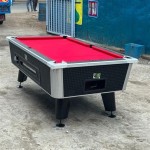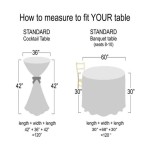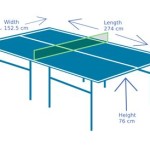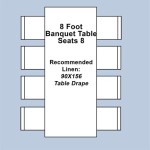French Inspired Table Settings: A Guide to Elegance and Refinement
French-inspired table settings are characterized by their emphasis on elegance, detail, and a sense of occasion. They transcend mere functionality, transforming a simple meal into an experience. Understanding the key elements involved in creating such a setting is crucial for anyone seeking to emulate this sophisticated aesthetic. This article provides an overview of the principles and components that contribute to a truly French-inspired dining experience.
Key Element 1: Linens and Textiles
The foundation of any French-inspired table setting lies in the quality and presentation of its linens. Crisp, clean tablecloths in neutral colors such as white, cream, or light gray are a staple. These colors provide a versatile backdrop that allows other elements of the setting to shine. Avoid patterns that are too busy or distracting; simplicity is key to maintaining an air of sophistication.
Material choice is equally important. Linen and cotton are the preferred fabrics due to their natural texture and ability to drape elegantly. A well-ironed tablecloth is essential, demonstrating attention to detail and creating a polished look. Consider using a tablecloth that extends at least 12 inches beyond the edge of the table to create a visually appealing overhang.
Napkins should complement the tablecloth in both color and fabric. They can be folded in a variety of classic styles, such as a simple rectangle, a pyramid, or a more elaborate fan fold. For a touch of personality, consider using napkin rings, which can range from simple silver bands to more ornate designs incorporating natural elements like leaves or flowers. Placement of the napkin is also important; it can be placed to the left of the forks, on the plate, or within a stemmed glass, depending on the formality of the occasion.
Beyond the tablecloth and napkins, placemats can also be incorporated, especially for more casual settings. These should also be in neutral tones or subtle patterns that complement the overall aesthetic. Woven placemats or those made from natural fibers like jute or seagrass can add a touch of rustic charm to a French-inspired table.
Key Element 2: Dinnerware and Glassware
The choice of dinnerware and glassware is paramount in creating a French-inspired table setting. Classic white porcelain is a popular choice, offering a timeless elegance and allowing the food to be the focal point. However, delicate patterns in soft colors like blue, green, or gold can also be used to add a touch of personality without overwhelming the setting.
A complete set of dinnerware typically includes a dinner plate, salad plate, soup bowl, and bread plate. The placement of these items follows a specific protocol. The dinner plate is placed in the center, with the salad plate stacked on top. The soup bowl is placed on the salad plate when soup is served. The bread plate is positioned to the upper left of the dinner plate.
Glassware is equally important in enhancing the dining experience. A French-inspired table setting typically includes a water glass, a wine glass for red wine, and a wine glass for white wine. The size and shape of the wine glasses are designed to enhance the aroma and flavor of the specific type of wine being served. Champagne flutes may also be included for celebratory occasions.
The arrangement of glassware follows a specific order, typically placed to the upper right of the dinner plate. The water glass is positioned closest to the plate, followed by the white wine glass, and then the red wine glass. This arrangement allows guests to easily identify and access the appropriate glass for each beverage.
Consider the overall aesthetic when selecting dinnerware and glassware. A cohesive look is achieved by choosing pieces that complement each other in terms of style, color, and material. While matching sets are a safe option, mixing and matching pieces with similar characteristics can add a touch of individuality and visual interest.
Key Element 3: Silverware and Utensils
Silverware, or flatware, plays a crucial role in completing a French-inspired table setting. Stainless steel is a practical and durable option for everyday use, while sterling silver offers a more luxurious and formal touch. The design of the silverware should be elegant and understated, avoiding overly ornate patterns that can detract from the overall aesthetic.
The placement of silverware follows a specific protocol that has been refined over centuries. The forks are placed to the left of the dinner plate, with the salad fork positioned on the outermost left, followed by the dinner fork. The knife is placed to the right of the dinner plate, with the blade facing inwards towards the plate. The spoon is placed to the right of the knife.
Additional utensils, such as soup spoons, dessert forks, and butter knives, are added as needed based on the menu. The soup spoon is placed to the right of the spoons. The dessert fork and spoon are typically brought out with the dessert course, placed horizontally above the dinner plate, with the fork tines pointing to the right and the spoon bowl pointing to the left. The butter knife is placed horizontally on the bread plate.
The order in which utensils are used progresses from the outside in, guiding guests through the different courses of the meal. This careful arrangement demonstrates attention to detail and helps to create a seamless and enjoyable dining experience. Polishing the silverware to a high shine is essential, reflecting the light and adding a touch of sparkle to the table.
Key Element 4: Decorative Accents and Centerpieces
Decorative accents and centerpieces add personality and visual interest to a French-inspired table setting. These elements should be carefully chosen to complement the overall aesthetic and create a welcoming atmosphere. Fresh flowers are a classic choice, adding a touch of natural beauty and fragrance to the table.
Floral arrangements should be elegant and understated, avoiding overly large or elaborate displays that can obstruct the view across the table. Simple bouquets of roses, lilies, or hydrangeas are popular choices, arranged in vases that complement the dinnerware and glassware. Consider using a single type of flower for a more minimalist look, or mixing different varieties for a more romantic and textured arrangement.
Candles are another essential element in creating a French-inspired ambiance. Taper candles in elegant holders can add a touch of romance and sophistication to the table. Alternatively, pillar candles in varying heights can be grouped together to create a more dramatic effect. Scented candles can also be used, but the fragrance should be subtle and not overpowering.
Other decorative accents, such as small figurines, antique silver pieces, or natural elements like shells or stones, can also be incorporated to add personality and visual interest. These elements should be chosen carefully to complement the overall aesthetic and avoid cluttering the table. Less is often more when it comes to decorative accents, so focus on selecting a few key pieces that will make a statement.
Key Element 5: Attention to Detail and Refinement
The essence of a French-inspired table setting lies in the attention to detail and the pursuit of refinement. Every element, from the linens to the silverware to the decorative accents, should be carefully chosen and arranged to create a cohesive and elegant look. This requires a keen eye for aesthetics and a commitment to creating a memorable dining experience.
One key aspect of attention to detail is ensuring that all elements of the table setting are clean, polished, and in good condition. Wrinkled tablecloths, tarnished silverware, or chipped dinnerware can detract from the overall aesthetic and create a negative impression. Taking the time to properly care for and maintain these items is essential for creating a truly French-inspired table setting.
Another important aspect is the placement of each element on the table. Following the proper etiquette for silverware placement, glassware arrangement, and napkin folding demonstrates attention to detail and respect for the dining experience. These seemingly small details can make a big difference in creating a sense of elegance and sophistication.
Finally, the overall atmosphere of the dining experience should be considered. Soft lighting, background music, and thoughtful conversation can all contribute to creating a welcoming and enjoyable ambiance. The goal is to create a space where guests feel comfortable, relaxed, and pampered, allowing them to fully appreciate the meal and the company.
By focusing on these key elements—linens and textiles, dinnerware and glassware, silverware and utensils, decorative accents and centerpieces, and attention to detail and refinement—anyone can create a French-inspired table setting that is both elegant and inviting. This careful orchestration of elements elevates the dining experience from a mere necessity to a cherished occasion.

How To Set A Simple French Country Summer Table Sanctuary Home Decor

How To Set A Simple French Country Summer Table Sanctuary Home Decor

Simple French Country Table Setting Idea For The Perfect Dinner Party Life On Summerhill

Fabulous Feature A French Inspired Table Setting Creative And Fun Wedding Ideas Made Simple Settings

Throw A Fabulous French Country Style Party With Courtney Allison S New Book Cottage Inspired Gatherings Fab Everyday

Simple French Country Table Setting Idea For The Perfect Dinner Party Life On Summerhill

15 Minute Fall French Country Table Porch Daydreamer

Simple Summer Eating Inspired By France Shabbyfufu Com

French Inspired Wedding Southern Beautiful Table Decorations Provence Herb

31 Days Of French Inspired Style Day 16 Tablescapes Blue Cottage








